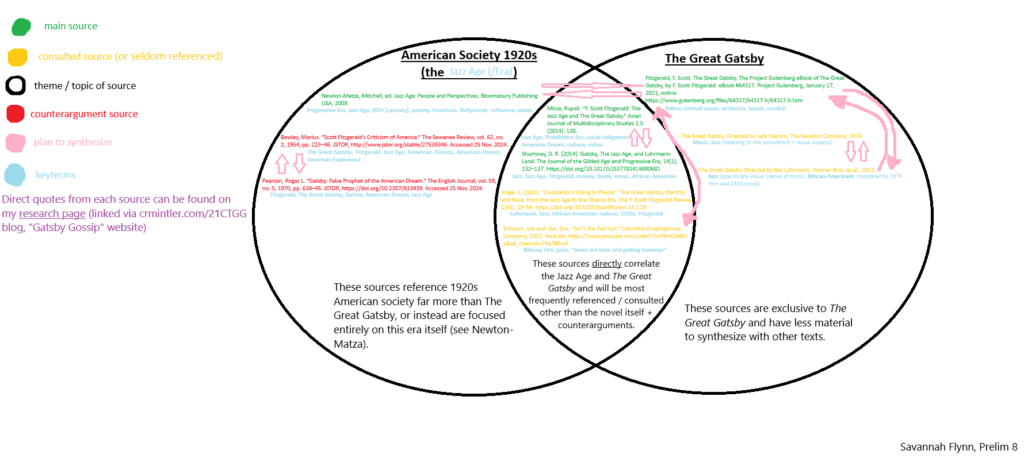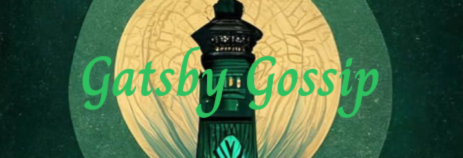I’ve found the additional source I needed to complete my paper, which will be shown in my revised writings below, as well as revised research ideas and topics to address in my paper. This is a new page / post to keep my ideas organized in one place.
Keyterms: Jazz Age, Jazz Era, Harlem Renaissance, The Great Gatsby, F. Scott Fitzgerald, Baz Luhrmann, American, culture, American Dream, 1920s, society, econom(y/ics), African-American
Introduction: establishing a very BRIEF historical context of the Jazz Age, introducing F. Scott Fitzgerald’s The Great Gatsby, connecting the two themes with a brief sentence relating the novel to the Jazz Age, and ending with a thesis.
- Draft thesis: Readers might not realize just how integrated The Great Gatsby is in the Jazz Age, with Fitzgerald emphasizing the state of American culture, economics, and social advancement, not just regarding music.
Body Paragraph 1: What the Jazz Age meant to F. Scott Fitzgerald
- Using “Gatsby, The Jazz Age, and Luhrmann Land” (Shumway) to determine how Fitzgerald defined the Jazz Age, synthesized with “F. Scott Fitzgerald: The Jazz Age and The Great Gatsby” (Mirza). Descriptions of the Jazz Age itself are given through “Jazz Age: People and Perspectives” (Newton-Matza).
Body Paragraph 2: Jazz Age prohibition and economics seen in The Great Gatsby
- Using Fitzgerald’s novel, Schenck and Van’s song “Ain’t We Got Fun,” and mostly textual evidence within the novel to describe how Fitzgerald incorporated his views of the Jazz Age itself into the book (wealth classes), along with the Shumway and Mirza sources above.
Body Paragraph 3: Jazz Age cultural advancement seen in The Great Gatsby
- Will reference the “modish” African-Americans seen in the novel with a matter of their appearance, the interpretation of such in Baz Luhrmann’s “The Great Gatsby” film synthesized with J. Vogel’s “‘Civilization’s Going to Pieces:’ The Great Gatsby, Identity, and Race, from the Jazz Age to the Obama Era”, and the Newton-Matza source above to describe how African-American culture drove this era.
- I would like to find a secondary source to back up this argument in regards to African-American culture driving the Jazz Age.
- Source found: Schneider, Mark Robert. African Americans in the jazz age: A decade of struggle and promise. Rowman & Littlefield, 2006.
- accessible through Google Scholar
Body Paragraph 4: Jazz Age social advancement seen in The Great Gatsby
- A subtle shift towards Civil Rights (Fitzgerald’s sarcastic reference with “The Rise of the Colored Empires”), and Fitzgerald’s rather cynical view on the American Dream despite how the majority of society was uplifted during this time, utilizing the counterargument sources “Gatsby: False Prophet of the American Dream” (Pearson) and “Scott Fitzgerald’s Criticism of America” (Bewley).
Body Paragraph 5: Jazz Age musical advancement seen in The Great Gatsby
- Baz Luhrmann film (specifically the scene with the African-American man playing music on the stairwell), Fitzgerald’s novel’s references to Van & Schenck and yellow cocktail music. I want this paragraph to be rather brief to lead into the conclusion.
Conclusion: A brief summary and restatement of my thesis
- I want to be able to split up my body paragraphs into multiple topics, but each sentence provides the main idea for each topic / section.
One of my sources is The Great Gatsby’s use of “Ain’t We Got Fun,” a song originally sung by the duo Van & Schenck in 1921. While most scenes in the novel discuss yellow cocktail music or various orchestras, this is the only song where lyrics are written out, emphasizing its importance. When we analyze the lyrics of the full song, aspects of American society become clearer. “The rent’s unpaid dear… Times are bum and getting bummer… The rich get rich and the poor get children… Landlords mad and getting madder… Times are so bad and getting badder… The rich get rich and the poor get laid off…” are just a few examples of how the singer-songwriters were aware of the trying times, economically and socially, after World War I, but as long as they were having fun, none of it mattered. This is reflected in The Great Gatsby with the juxtaposition between West and East Egg, and the valley of ashes. East Egg, with the rich citizens, seems to portray an idyllic society with little care except glamor, parties, and gaining wealth, and West Egg represents the up-and-coming wealth of the new generation of business and the economy. Meanwhile, the valley of ashes, filled with factories and depressed workers, represents lower-class citizens struggling to make ends meet.

